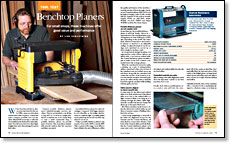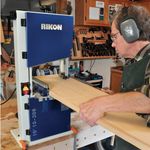Tool Test: Benchtop Planers
For small shops, these machines offer good value and performance
Synopsis: Nine benchtop thickness planers were given a hands-on test to evaluate their accuracy and smoothness of cutting. Lon Schleining also tested them for ease in changing knives and other adjustments, effectiveness of dust collection, and price. The results are filled with in-depth, specific details to help you pick the planer that will work best for you.
When benchtop thickness planers were introduced in the early 1980s, many woodworkers viewed them with suspicion, certain that such a compact, portable, low-cost machine offered little more than a collection of assembled parts destined for early retirement. Over the years, however, these lightweights have more than managed to prove their value.
Granted, portable thickness planers aren’t industrial-strength cast-iron machines. They’re not intended to run all day or hog off 1 ⁄4 in. of stock in a single pass. But for occasional use, as in a home shop or even a small commercial shop, a portable thickness planer can provide years of service. Plus, it produces remarkably smooth surfaces that few cast-iron machines can match.
A portable thickness planer has other advantages. Compared with bigger planers, it’s a lot friendlier on the budget. And because it’s relatively light, a portable planer can be picked up and stored out of the way when it’s not in use.
Today’s portable thickness planers vary in price from under $300 to nearly $500. That’s a pretty wide range. In an effort to learn whether the price differences reflect the quality and features of the machines, I recently put nine of them through a handson test: Central Machinery 6469-5VGA (sold by Harbor Freight), Delta 22-580, DeWalt DW733, Geetech CT-345 (sold by Sunhill), Grizzly G8794, Jet JWP-12DX, Makita 2012NB, Pro-Tech CS6005 and Ridgid TP1300LS (sold by The Home Depot).
Portable thickness planers are not complex tools
As machines go, the portable thickness planer is relatively simple. Driven by a universal motor, the cutterhead spins a pair of long knives at some 8,000 rpm to 10,000 rpm, depending on the model. The cutterhead, which is located above the board to be planed, is attached to an adjustable carriage. To adjust the depth of cut, the carriage and cutterhead are moved up or down simply by turning a crank.
As a board travels though the planer, it is supported by a series of three surfaces—an infeed table, a bed and an outfeed table. The Central Machinery planer includes a pair of rollers in the bed, a feature commonly found only on larger planers.
When the cutterhead is lowered to make a planing cut, a pair of spring-loaded, rubber-coated feed rollers (one in front of the cutterhead and one behind) moves up and down along with the cutterhead and contact the top face of the board as it enters and exits the machine. Powered by the motor, the rollers slowly rotate to feed the board through the machine while holding it firmly against the bed.
From Fine Woodworking #160
For the full article, download the PDF below:
Fine Woodworking Recommended Products

Ridgid EB4424 Oscillating Spindle/Belt Sander

Veritas Precision Square

Rikon 10-3061 10-in. Deluxe Bandsaw
The saw has two speeds: 3,280 sfpm (surface feet per minute) for wood and 1,515 sfpm for soft metals and some plastics.





















Log in or create an account to post a comment.
Sign up Log in